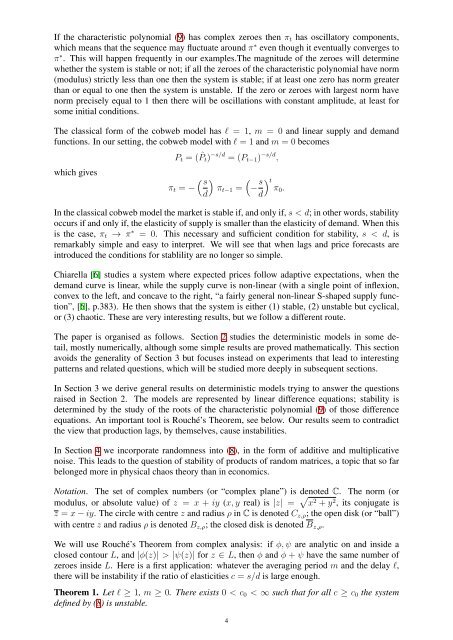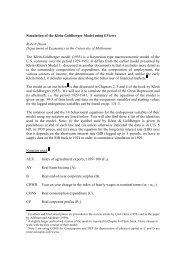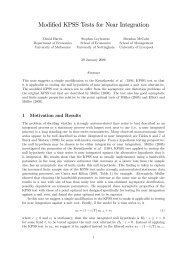Cobweb Theorems with production lags and price forecasting
Cobweb Theorems with production lags and price forecasting
Cobweb Theorems with production lags and price forecasting
Create successful ePaper yourself
Turn your PDF publications into a flip-book with our unique Google optimized e-Paper software.
If the characteristic polynomial (9) has complex zeroes then πt has oscillatory components,<br />
which means that the sequence may fluctuate around π ∗ even though it eventually converges to<br />
π ∗ . This will happen frequently in our examples.The magnitude of the zeroes will determine<br />
whether the system is stable or not; if all the zeroes of the characteristic polynomial have norm<br />
(modulus) strictly less than one then the system is stable; if at least one zero has norm greater<br />
than or equal to one then the system is unstable. If the zero or zeroes <strong>with</strong> largest norm have<br />
norm precisely equal to 1 then there will be oscillations <strong>with</strong> constant amplitude, at least for<br />
some initial conditions.<br />
The classical form of the cobweb model has ℓ = 1, m = 0 <strong>and</strong> linear supply <strong>and</strong> dem<strong>and</strong><br />
functions. In our setting, the cobweb model <strong>with</strong> ℓ = 1 <strong>and</strong> m = 0 becomes<br />
which gives<br />
Pt = ( ˆ Pt) −s/d = (Pt−1) −s/d ,<br />
πt = −<br />
�<br />
s<br />
� �<br />
πt−1 =<br />
d<br />
− s<br />
d<br />
� t<br />
π0.<br />
In the classical cobweb model the market is stable if, <strong>and</strong> only if, s < d; in other words, stability<br />
occurs if <strong>and</strong> only if, the elasticity of supply is smaller than the elasticity of dem<strong>and</strong>. When this<br />
is the case, πt → π ∗ = 0. This necessary <strong>and</strong> sufficient condition for stability, s < d, is<br />
remarkably simple <strong>and</strong> easy to interpret. We will see that when <strong>lags</strong> <strong>and</strong> <strong>price</strong> forecasts are<br />
introduced the conditions for stablility are no longer so simple.<br />
Chiarella [6] studies a system where expected <strong>price</strong>s follow adaptive expectations, when the<br />
dem<strong>and</strong> curve is linear, while the supply curve is non-linear (<strong>with</strong> a single point of inflexion,<br />
convex to the left, <strong>and</strong> concave to the right, “a fairly general non-linear S-shaped supply function”,<br />
[6], p.383). He then shows that the system is either (1) stable, (2) unstable but cyclical,<br />
or (3) chaotic. These are very interesting results, but we follow a different route.<br />
The paper is organised as follows. Section 2 studies the deterministic models in some detail,<br />
mostly numerically, although some simple results are proved mathematically. This section<br />
avoids the generality of Section 3 but focuses instead on experiments that lead to interesting<br />
patterns <strong>and</strong> related questions, which will be studied more deeply in subsequent sections.<br />
In Section 3 we derive general results on deterministic models trying to answer the questions<br />
raised in Section 2. The models are represented by linear difference equations; stability is<br />
determined by the study of the roots of the characteristic polynomial (9) of those difference<br />
equations. An important tool is Rouché’s Theorem, see below. Our results seem to contradict<br />
the view that <strong>production</strong> <strong>lags</strong>, by themselves, cause instabilities.<br />
In Section 4 we incorporate r<strong>and</strong>omness into (8), in the form of additive <strong>and</strong> multiplicative<br />
noise. This leads to the question of stability of products of r<strong>and</strong>om matrices, a topic that so far<br />
belonged more in physical chaos theory than in economics.<br />
Notation. The set of complex numbers (or “complex plane”) is denoted C. The norm (or<br />
modulus, or absolute value) of z = x + iy (x, y real) is |z| = � x 2 + y 2 , its conjugate is<br />
z = x − iy. The circle <strong>with</strong> centre z <strong>and</strong> radius ρ in C is denoted Cz,ρ; the open disk (or “ball”)<br />
<strong>with</strong> centre z <strong>and</strong> radius ρ is denoted Bz,ρ; the closed disk is denoted Bz,ρ.<br />
We will use Rouché’s Theorem from complex analysis: if φ, ψ are analytic on <strong>and</strong> inside a<br />
closed contour L, <strong>and</strong> |φ(z)| > |ψ(z)| for z ∈ L, then φ <strong>and</strong> φ + ψ have the same number of<br />
zeroes inside L. Here is a first application: whatever the averaging period m <strong>and</strong> the delay ℓ,<br />
there will be instability if the ratio of elasticities c = s/d is large enough.<br />
Theorem 1. Let ℓ ≥ 1, m ≥ 0. There exists 0 < c0 < ∞ such that for all c ≥ c0 the system<br />
defined by (8) is unstable.<br />
4







